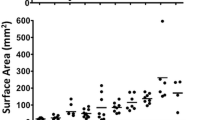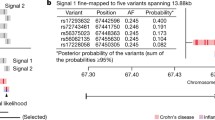Abstract
Induction of colitis in mice by a targeted mutation in the Il10 gene is inbred strain dependent. C3H/HeJBir (C3H) mice are colitis susceptible while C57BL/6J (B6) mice are resistant. Identification of quantitative trait loci (QTL) determining the differential strain responsiveness requires histopathologic scoring of multiple lesion subphenotypes in both cecum and colon. Here we show that ability to detect a major C3H-derived QTL on Chr 3 (cytokine deficiency–induced colitis susceptibility 1, Cdcs1) was critically dependent upon the degree of refinement of the histopathologic scoring system. QTL mapping was performed using a first-backcross population of interleukin-10-deficient mice and applying two different grading systems to assess lesion subphenotypes. The same histological specimens were scored by two independent pathologists using either a very detailed scoring system for four subphenotypes developed at The Jackson Laboratory (TJL) or a simpler scoring system developed at the Hannover Medical School (MHH). The more detailed TJL subphenotyping protocol increased power to identify Cdcs1 (a maximum LOD score of 4.28 versus a LOD score of 1.77 when using the abbreviated MHH subphenotyping scoring system). This study shows that for QTL mapping in a mouse model of colitis, in which histology represents the gold standard for phenotyping, ability to detect linkage is critically dependent upon the degree of refinement adopted for separately scoring the multiple histopathologic lesions comprising this complex phenotype.



Similar content being viewed by others
References
ID Arnott J Satsangi (2003) ArticleTitleCrohn’s disease or Crohn’s diseases? Gut 52 460–461 Occurrence Handle10.1136/gut.52.4.460 Occurrence Handle1:STN:280:DC%2BD3s7hvVahsQ%3D%3D Occurrence Handle12631650
C Asseman S Mauze MW Leach RL Coffman F Powrie (1999) ArticleTitleAn essential role for interleukin 10 in the function of regulatory T cells that inhibit intestinal inflammation J Exp Med 190 995–1004 Occurrence Handle10.1084/jem.190.7.995 Occurrence Handle1:CAS:528:DyaK1MXmsVClt7s%3D Occurrence Handle10510089
DJ Berg N Davidson R Kühn W Müller S Menon et al. (1996) ArticleTitleEnterocolitis and colon cancer in interleukin-10-deficient mice are associated with aberrant cytokine production and CD4(+) TH1-like responses J Clin Invest 98 1010–1020 Occurrence Handle1:CAS:528:DyaK28XlsFOgt7w%3D Occurrence Handle8770874
IJ Bristol MA Farmer Y Cong XX Zheng TB Strom et al. (2000) ArticleTitleHeritable susceptibility for colitis in mice induced by IL-10 deficiency Inflamm Bowel Dis 6 290–302 Occurrence Handle1:STN:280:DC%2BD3M3jtF2isw%3D%3D Occurrence Handle11149562
GA Churchill RW Doerge (1994) ArticleTitleEmpirical threshold values for quantitative trait mapping Genetics 138 963–971 Occurrence Handle1:STN:280:ByqC2MvntFw%3D Occurrence Handle7851788
LA Dieleman A Arends SL Tonkonogy MS Goerres DW Craft et al. (2000) ArticleTitleHelicobacter hepaticus does not induce or potentiate colitis in interleukin-10-deficient mice Infect Immun 68 5107–5113 Occurrence Handle10.1128/IAI.68.9.5107-5113.2000 Occurrence Handle1:CAS:528:DC%2BD3cXmtVeks7k%3D Occurrence Handle10948132
CO Elson RB Sartor GS Tennyson RH Riddell (1995) ArticleTitleExperimental models of inflammatory bowel disease Gastroenterology 109 1344–1367 Occurrence Handle1:STN:280:BymD38bjsVU%3D Occurrence Handle7557106
MA Farmer JP Sundberg IJ Bristol GA Churchill R Li et al. (2001) ArticleTitleA major quantitative trait locus on chromosome 3 controls colitis severity in IL-10-deficient mice Proc Natl Acad Sci USA 98 13820–13825 Occurrence Handle10.1073/pnas.241258698 Occurrence Handle1:CAS:528:DC%2BD3MXovVyntL4%3D Occurrence Handle11707574
T Hibi H Ogata A Sakuraba (2002) ArticleTitleAnimal models of inflammatory bowel disease J Gastroenterol 37 409–417 Occurrence Handle10.1007/s005350200060 Occurrence Handle1:CAS:528:DC%2BD38Xls1ejsrw%3D Occurrence Handle12108674
JP Hugot M Chamaillard H Zouali S Lesage JP Cezard et al. (2001) ArticleTitleAssociation of NOD2 leucine-rich repeat variants with susceptibility to Crohn’s disease Nature 411 599–603 Occurrence Handle10.1038/35079107 Occurrence Handle1:CAS:528:DC%2BD3MXksVShtLY%3D Occurrence Handle11385576
A Konrad M Mähler B Flogerzi MB Kalousek J Lange et al. (2003) ArticleTitleAmelioration of murine colitis by feeding a solution of lysed Escherichia coli Scand J Gastroenterol 38 172–179 Occurrence Handle1:STN:280:DC%2BD3s7mtFWjtg%3D%3D Occurrence Handle12678334
R Kühn J Löhler D Rennick K Rajewsky W Müller (1993) ArticleTitleInterleukin-10-deficient mice develop chronic enterocolitis Cell 75 263–274 Occurrence Handle8402911
MC Kullberg JM Ward PL Gorelick P Caspar S Hieny et al. (1998) ArticleTitleHelicobacter hepaticus triggers colitis in specific-pathogen-free interleukin-10 (IL-10)-deficient mice through an IL-12- and gamma interferon-dependent mechanism Infect Immun 66 5157–5166 Occurrence Handle1:CAS:528:DyaK1cXntFWms7Y%3D Occurrence Handle9784517
KL Madsen JS Doyle LD Jewell MM Tavernini RN Fedorak (1999) ArticleTitleLactobacillus species prevents colitis in interleukin 10 gene-deficient mice Gastroenterology 116 1107–1114 Occurrence Handle1:STN:280:DyaK1M3jvVyrtg%3D%3D Occurrence Handle10220502
M Mähler IJ Bristol JP Sundberg GA Churchill EH Birkenmeier et al. (1999) ArticleTitleGenetic analysis of susceptibility to dextran sulfate sodium-induced colitis in mice Genomics 55 147–156 Occurrence Handle10.1006/geno.1998.5636 Occurrence Handle9933561
M Mähler C Most S Schmidtke JP Sundberg R Li et al. (2002) ArticleTitleGenetics of colitis susceptibility in IL-10-deficient mice: backcross versus F2 results contrasted by principal component analysis Genomics 80 274–282 Occurrence Handle10.1006/geno.2002.6840 Occurrence Handle12213197
C Moolenbeek EJ Ruitenberg (1981) ArticleTitleThe “Swiss roll”: a simple technique for histological studies of the rodent intestine Lab Anim 15 57–59 Occurrence Handle1:STN:280:Bi6B28fnvFY%3D Occurrence Handle7022018
W Nicklas P Baneux R Boot T Decelle AA Deeny et al. (2002) ArticleTitleRecommendations for the health monitoring of rodent and rabbit colonies in breeding and experimental units Lab Anim 36 20–42 Occurrence Handle10.1258/0023677021911740 Occurrence Handle1:CAS:528:DC%2BD38XitFyqsb8%3D Occurrence Handle11831737
Y Ogura DK Bonen N Inohara DL Nicolae FF Chen et al. (2001) ArticleTitleA frameshift mutation in NOD2 associated with susceptibility to Crohn’s disease Nature 411 603–606 Occurrence Handle10.1038/35079114 Occurrence Handle1:CAS:528:DC%2BD3MXksVShur8%3D Occurrence Handle11385577
RK Sellon S Tonkonogy M Schultz LA Dieleman W Grenther et al. (1998) ArticleTitleResident enteric bacteria are necessary for development of spontaneous colitis and immune system activation in interleukin-10-deficient mice Infect Immun 66 5224–5231 Occurrence Handle1:CAS:528:DyaK1cXntFWmsLk%3D Occurrence Handle9784526
S Sen GA Churchill (2001) ArticleTitleA statistical framework for quantitative trait mapping Genetics 159 371–387 Occurrence Handle1:STN:280:DC%2BD3MrhtlShsA%3D%3D Occurrence Handle11560912
MS Silverberg MJ Daly DN Moskovitz JD Rioux RS McLeod et al. (2001) ArticleTitleDiagnostic misclassification reduces the ability to detect linkage in inflammatory bowel disease genetic studies Gut 49 773–776 Occurrence Handle10.1136/gut.49.6.773 Occurrence Handle1:STN:280:DC%2BD3MnmtlOiuw%3D%3D Occurrence Handle11709510
JP Sundberg CO Elson H Bedigian EH Birkenmeier (1994) ArticleTitleSpontaneous, heritable colitis in a new substrain of C3H/HeJ mice Gastroenterology 107 1726–1735 Occurrence Handle1:STN:280:ByqD2cjhsFQ%3D Occurrence Handle7958684
Acknowledgments
This work was supported in part by grants from the National Institutes of Health (DK44240, CE, EHL, JPS, RR173, JPS), National Cancer Institute (CA34196, EHL, JPS), and Deutsche Forschungsgemeinschaft (SFB 280, HJH, MM; GK 705, AB). The authors gratefully acknowledge the excellent technical assistance of W. Arndt, J. Beckwith, I. Köhn, J. Smith, and A. Smoczek.
Author information
Authors and Affiliations
Corresponding author
Rights and permissions
About this article
Cite this article
Bleich, A., Mähler, M., Most, C. et al. Refined histopathologic scoring system improves power todetect colitis QTL in mice. Mamm Genome 15, 865–871 (2004). https://doi.org/10.1007/s00335-004-2392-2
Received:
Accepted:
Issue Date:
DOI: https://doi.org/10.1007/s00335-004-2392-2




